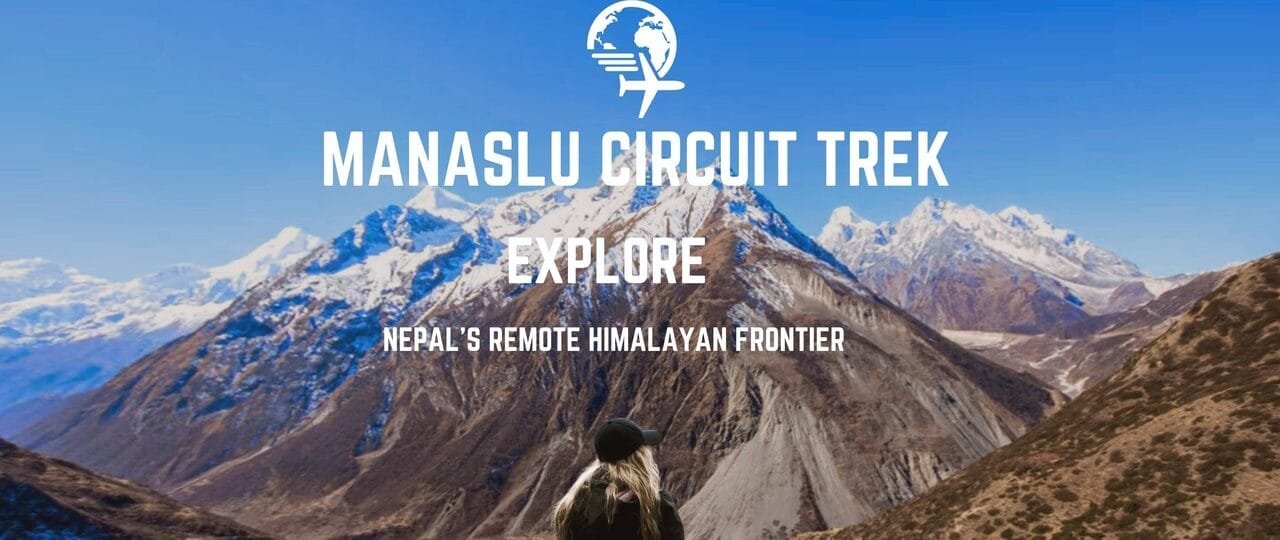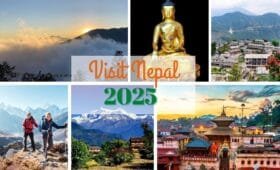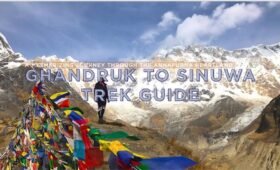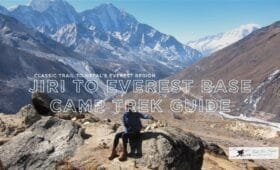The Manaslu Circuit Trek is a hidden gem in Nepal’s mountainous scenery. It offers awe-inspiring views, cultural immersion, and fewer crowds than the more famous Annapurna and Everest regions. For adventurous souls seeking pristine trails, the Manaslu Trek is a prime choice for a serene yet challenging route. Manaslu Circuit Trekking immerses hikers in a region characterized by Tibetan-influenced communities, unspoiled forests, and dramatic peaks, including Mount Manaslu, the world’s eighth-highest mountain at 8,163 meters.
This extensive guide details every aspect, from the Manaslu Circuit Trek Itinerary and Manaslu Circuit Trek Cost to the best time to go, recommended gear, and how to choose the right Manaslu Circuit Trek Package. You’ll learn about the typical distance, difficulty level, essential permits, and the need for a reliable guide. We’ll also touch upon altitude issues, typical weather, and considerations regarding accommodation. You’ll grasp everything from duration to crucial safety and planning tips by the end. Let’s explore why this route, sometimes overshadowed by its neighbors, is fast becoming an unmissable Himalayan journey.
1. Introduction: Why the Manaslu Circuit Trek?
The Manaslu Circuit Trek circles Mount Manaslu (8,163m), rewarding you with panoramic vistas of Manaslu itself, Ganesh Himal, and the Annapurna range. The region was opened to trekkers in 1991 yet remains less commercialized than other Nepali routes. This exclusivity stems partly from restricted area requirements, limited teahouses in some stretches, and moderate altitude challenges. Still, those who embark on Manaslu Circuit Trekking often report it as a highlight of their Himalayan experiences.
Statistic: According to Nepal’s Department of Immigration, about 10,000–12,000 trekkers tackle the Manaslu region yearly—far fewer than the 40,000–60,000 who choose Annapurna. That disparity offers a more tranquil, wilderness-like vibe.
Quote:
“The Manaslu Trek was like stepping into old-world Nepal. I walked through monasteries that felt centuries untouched, seeing precious cultural rituals rarely glimpsed on busier trails,” says Anna, a 32-year-old hiker from Sweden who completed the loop last season.
2. Historical & Cultural Overview
Mount Manaslu, revered as “the spirit mountain,” draws from the Sanskrit term “manasa,” meaning intellect or soul. The Manaslu region sits north of Gorkha District, forging trade links with Tibet over centuries. Local communities, predominantly Gurung, Nubri, and Tsum, share ties with Tibetan Buddhism, evident in monasteries, chortens, and prayer flags lining footpaths.
In the 1950s, Japanese expeditions famously scaled Manaslu’s summit, bringing global attention to the area. However, daily life remains anchored in traditions blending agriculture, yak herding, and labyrinthine trade routes. This legacy shapes the area’s culture: visiting the region fosters an intimate look at Tibetan-influenced customs alongside mesmerizing Himalayan landscapes.
3. Key Highlights of Manaslu Circuit Trek Itinerary
A standard Manaslu Circuit Trek Itinerary spans 14–18 days, though some travelers extend it to incorporate side trips (like Tsum Valley). Below is a common framework:
- Day 1–2: Kathmandu to Soti Khola (700m)
Around 7–8 hours by bus or jeep from Kathmandu. Soti Khola is the typical starting point, nestled by the Budhi Gandaki River. - Day 3–5: Machha Khola to Jagat / Deng
Trails alternate between forested hills, terraced fields, and small villages. The region remains warm, but you’ll notice subtle climbs daily. - Day 6–7: Namrung, Lho, and Samagaon (3,530m)
The route ascends above 2,500m, offering glimpses of Manaslu. Samagaon is a cultural hub with a centuries-old monastery. - Day 8–9: Samagaon Acclimatization & Samdo
Spend an extra day adjusting to the rising altitude. Explore side trails to Manaslu Base Camp or local vantage points. Then, move on to Samdo, a Tibetan-influenced hamlet near the border. - Day 10–12: Larkya Phedi to Larkya La Pass (5,160m)
This is the biggest test. A pre-dawn start helps you navigate the pass, which can be icy—reaching the top grants panoramic views of Cheo Himal, Kang Guru, and Annapurna II. - Day 13–14: Bimthang, Dharapani, and Exiting
Descend across farmland ridges toward the Annapurna region’s gateway—many end at Dharapani, connecting to bus routes back to Kathmandu.
Manaslu Circuit Trek Distance hovers around 170–200 km, influenced by route variations and optional side treks. The highlight, Larkya La Pass, stands as the loop’s apex, bridging you into the Marsyangdi valley near Annapurna.
4. Understanding the Manaslu Circuit Trek Difficulty
Classified as moderate-to-challenging, the Manaslu Circuit Trek Difficulty stems from:
- Remoteness: Fewer teahouses, especially pre-Deng, plus limited road access.
- Altitude: Larkya La reaches 5,160m, requiring thorough acclimatization.
- Varied Terrain: Trails shift between narrow ridges, farmland tracks, and glacial moraines.
Regular cardio (running, swimming) and leg-strength routines (squats, step workouts) can streamline daily ascents. Manaslu feels like a natural next step if you’ve completed mid-range treks (like Annapurna Base Camp or Langtang).
5. Mapping Your Route: A Look at the Manaslu Circuit Trek Map
A robust Manaslu Circuit Trek Map helps ensure you navigate permissible areas since part of the route is restricted. The main points:
- Soti Khola–Jagat: Lower elevation, subtropical climate, crossing the Budhi Gandaki multiple times.
- Deng–Samagaon: Scenic ascents, forest transitions, culminating in Tibetan-like plateaus near Samagaon.
- Samdo–Larkya Phedi: Pre-pass section. Basic accommodations. Crisp air.
- Larkya La Pass: The route’s apex is windy and occasionally snowy.
- Descent to Bimthang, Dharapani: A shift into greener valleys meets the Annapurna region. A GPS device or smartphone map is helpful, but local guides typically manage route choices. Paper maps remain a failsafe if tech fails.
6. How Much Does It Cost? Explaining the Manaslu Circuit Trek Cost
Due to restricted area fees, your Manaslu Circuit Trek Cost runs higher than standard routes. A typical breakdown:
- Permits:
- Manaslu Restricted Permit: ~USD 70 for the first 7 days (Sept–Nov), USD 50 for other months, plus USD 10 per extra day.
- MCAP (Manaslu Conservation Area Permit): ~USD 30.
- ACAP (Annapurna Conservation Area Permit): ~USD 30 if you exit via Dharapani.
- TIMS (Trekkers’ Information Management System): Often waived for restricted areas, but check current rules.
- Guide / Porter:
- A licensed guide is mandatory for restricted areas. Rates: ~USD 25–40/day.
- Porters: ~USD 15–25/day.
- Transport:
- The bus from Kathmandu to Soti Khola or Arughat costs USD 10–15. A private jeep costs USD 150–200.
- Food & Accommodation:
- Teahouse rooms: ~USD 3–5/night lower down, rising slightly with altitude.
- Meals: ~USD 20–30/day for three meals plus hot drinks.
Pro Tip: A mid-range Manaslu Circuit Trek Package might cost ~USD 900–1,400, factoring in guide wages, permits, lodging, and meals for ~14–16 days. Always confirm what’s included.
7. Booking the Right Manaslu Circuit Trek Package
Because a guide is mandatory, many travelers prefer a full or partial Manaslu Circuit Trek Package. This approach includes:
- Guide and Porter: Typically, there is one English-speaking guide for every 4–5 trekkers, plus porters for heavy gear.
- Permits: Agencies handle restricted, MCAP, ACAP, or TIMS fees.
- Teahouse Reservations: A boon in busy seasons.
- Logistics: Transport to/from the trailhead and potential side trips.
Group packages reduce costs but limit itinerary flexibility. Private tours cost more but let you tailor the daily route, side excursions, and pacing. If you want Tsum Valley or any unique add-ons, ensure your package covers them.
8. Securing Manaslu Circuit Trek Permits
Manaslu Circuit Trek Permits differ by region and season. The government mandates:
- Restricted Area Permit:
- Valid for the specific timeframe listed on your application.
- Issued only to groups of at least two trekkers plus a licensed guide.
- Manaslu Conservation Area Permit (MCAP):
- ~USD 30 for the protected area portion.
- Annapurna Conservation Area Permit (ACAP):
- Another ~USD 30 if your route extends into the Annapurna region near Dharapani.
- TIMS:
- Often replaced by the restricted permit, but always verify current rules.
You or your agency must have your original passport, visa, and at least two passport photos. Keep the physical copies—rangers at local checkpoints will check them.
9. Manaslu Circuit Trek Best Time: Seasons & Weather
Manaslu Circuit Trek Weather remains mild at lower altitudes but can be unpredictable near Larkya La Pass. The Manaslu Circuit Trek Best Time is commonly:
- Autumn (Sept–Nov): Dry and stable, with minimal cloud coverage and moderate temperatures. Busy but manageable.
- Spring (Mar-May): Blooming rhododendrons have decent visibility, though some haze might appear in the afternoons.
- Winter (Dec–Feb): Sub-zero nights above 3,000m, possible snow closing Larkya La, yet tranquil if you’re prepared.
- Monsoon (Jun–Aug): Heavy rains and potential landslides hamper certain roads. The route sees fewer trekkers, though higher areas remain in a rain shadow for partial dryness.
10. Hiring a Manaslu Circuit Trek Guide
A licensed Manaslu Circuit Trek Guide is mandatory for the restricted area. This ensures compliance with safety regulations and provides:
- Cultural Insight: Explaining monastery rules or local traditions in Nubri or Tsum.
- Altitude & Route Management: Setting daily targets and selecting teahouses.
- Crisis Response: Organizing helicopter evacuation or safe descent if needed.
Guide wages often exclude personal tips (USD 2–4/day recommended). Some travelers hire an additional porter for heavier gear. Agencies typically handle guide backgrounds, ensuring they’re bilingual and first-aid trained.
11. Preparation & Tips for Success
Physical Readiness
- Cardio: Run, bike, or swim thrice weekly for 4–6 weeks pre-trek.
- Strength: Weighted lunges, squats, and step sessions mimic daily climbs.
- Warm-up Hikes: If time allows, do short treks near Kathmandu or Pokhara for altitude adaptation.
Packing Essentials
- Layers: Thermal base, mid-layer fleece, waterproof jacket, beanie, gloves.
- Footwear: Trekking boots with firm ankle support; break them in beforehand.
- Misc. Items: Sunglasses, sunscreen, basic first-aid kit, water purifier or tablets.
Altitude Strategy
A slow pace after 3,000m is vital. The route surpasses 5,000m at Larkya La. Symptoms like mild headache or reduced appetite can sign altitude stress. If worsened, rest or descend. Diamox is an option but consult a doctor first.
12. Stories from the Trail: Testimonials & Inspiration
Carlos’s Triumph
Carlos, a software engineer from Spain, joined a small group for the Manaslu Circuit Trek. He recounts, “We started as strangers but bonded daily over the tough climbs and shared sunsets. Crossing Larkya La was surreal, seeing glaciers on one side and endless valleys on the other.”
Community Impact
Since tourism in Manaslu is regulated, revenue more directly supports local communities. Sita, who runs a teahouse in Deng, remarks, “Each season, we greet new faces. Their spending helps us rebuild trails after monsoon damage, pay school fees, and keep our cultural festivals vibrant.”
13. Seven Most Frequently Asked Questions
How long is the route, and what is the duration of the Manaslu Circuit Trek?
Typically, it takes 14–18 days, though road expansions allow starting further, reducing it to ~12 days.
Is it mandatory to hire a guide?
Yes. A licensed guide is required because Manaslu is a restricted zone.
What is the typical Manaslu Circuit Trek Cost?
Permit fees cost USD 70–100 for the first 7 days in peak months, plus daily increments. A mid-range package might total USD 900–1,400.
How challenging is the Manaslu Circuit Trek Difficulty?
Rated moderate-to-challenging. The pass at 5,160m demands careful acclimatization and strong fitness.
Which permits are essential?
Restricted Area Permit, MCAP, ACAP, and possibly TIMS. Confirm with your operator.
When is the Manaslu Circuit Trek Best Time?
Autumn (Sept–Nov) and spring (March) for stable weather. Winter sees fewer crowds but colder nights, while monsoon sees heavy rain in lower areas.
How does it compare to other treks?
It is less commercial than Annapurna or Everest. The terrain is more remote and culturally Tibetan, offering an unspoiled wilderness vibe.
14. Conclusion
Graceful peaks, remote monasteries, and cultural authenticity define the Manaslu Circuit Trek. While overshadowed by Annapurna or Everest, this route delivers an unparalleled blend of solitude and communal warmth. From the Budhi Gandaki’s narrow gorges to the windy Larkya La Pass, each step resonates with the presence of a vibrant local heritage. Manaslu Trek is your top contender if you seek a lesser-known but equally breathtaking Himalayan path.
Join ViN’s Mission
At Volunteers Initiative Nepal (ViN), we believe in forging deeper connections between travelers and Himalayan communities. Transform your Manaslu Circuit Trekking into more than a personal achievement—let it empower the region’s people:
- Volunteer: Offer expertise in education, healthcare, or environmental initiatives near Gorkha or other villages en route.
- Intern: Conduct studies or help gather data on local socio-economic challenges, bridging academic pursuits with community solutions.
- Donate: Support vital programs in health or schooling, ensuring that tourism revenue is invested back into sustaining remote villages.
- Share: Encourage friends, family, or peers to pair meaningful volunteer projects with their Himalayan treks, fueling synergy between culture and travel.
Namaste, and may your footsteps along Manaslu’s mesmerizing ridges affirm a spirit of exploration, compassion, and resilience. The mountains stand tall, but so does the local pride in forging a sustainable future. We at ViN welcome you to become part of this journey—where each step uncovers hidden wonders and fosters genuine impacts that resonate beyond the trail.
Additional Info & Practical Tips
While the main sections address the core aspects of the Manaslu Circuit Trek, a more profound exploration of specific nuances can help prospective trekkers refine their plans.
I. Seasonal Breakdown & Manaslu Circuit Trek Weather
1. Autumn (Sept–Nov)
- Clear weather. Daytime temperatures range from 15–20°C at mid-range elevations, but nights are near or below freezing above 3,000m. Larkya La can be windy or lightly snowed on.
- Crisp mountain views, letting you see Manaslu, Himalchuli, and Ganesh Himal against azure skies.
2. Spring (Mar-May)
- Forests bloom in rhododendrons, especially near the lower segments. An afternoon haze is possible. Temperatures remain moderate, making passes manageable.
3. Winter (Dec–Feb)
- Freezing nights. Larkya La might be icy or fully snow-blocked. Some teahouses at higher altitudes close.
- Solitude-overs are well-equipped for cold weather and can still attempt it, but it’s riskier.
4. Monsoon (Jun–Aug)
- Frequent rain in lower valleys, potential landslides along roads. The higher region might get less rain, but clouds hamper panoramic views.
II. Manaslu Circuit Trek Accommodation & Food
Unlike major touristy routes, the teahouses in Manaslu remain simple, yet progress is ongoing. Past Deng, lodging can be scarce, so arrive early to secure a room. Rates typically run ~USD 3–5 per night but may rise as you ascend.
Meals revolve around dal bhat (lentils, rice, vegetables), instant noodles, chapatis, or momos. Expect to pay ~USD 3–6 per meal, more at higher spots. Some areas accept only Nepali rupees, so carry enough cash.
III. Transportation & Access
The journey to the trailhead has evolved:
- Kathmandu → Soti Khola or Arughat: Public buses cost USD 10–15 and take about 7–8 hours. Private jeeps can shorten the drive but cost ~USD 150–200.
- Exiting from Dharapani: After the trek, many catch a jeep to Besisahar (~1.5–2 hours), then a bus to Kathmandu or Pokhara.
IV. Trekking Etiquette & Cultural Sensitivity
Respecting Locals
Tibet-influenced areas have monasteries, chortens, and mani walls. Always go around these walls clockwise and remove shoes inside temples. Interact politely and greet with “Namaste” or “Tashi Delek” (Tibetan). Purchasing local handicrafts, or at least dining at local teahouses, helps small communities.
Minimizing Environmental Footprint
Carry a reusable water bottle with purifier tablets or a filtration system. Plastic bottle usage is frowned upon. Additionally, bring a personal trash bag for wrappers or plastic. Some remote villages have limited waste management infrastructure.
V. Safety & Health Precautions
Insurance
Policies must cover trekking above 5,000m, ensuring helicopter rescue if altitude or injury strikes near Larkya La. Confirm the policy’s “adventure sports” coverage.
Health
Drink ~3 liters daily, integrated with electrolytesSupposeIf you sense altitude sickness—persistent headaches, dizziness—rest or descend promptly. Guides typically carry basic first aid, but personal medication is vital.
VI. Tsum Valley Extension
Many travelers combine Tsum Valley with the Manaslu Circuit for an enriched ~21–24-day trek. Tsum Valley boasts ancient Tibetan Buddhist culture, remote villages, and revered monasteries like Mu Gompa. Doing so requires an additional permit (Tsum Valley Restricted Permit), but it’s a surefire way to deepen cultural exploration.
VII. Potential Volunteer Engagement with ViN
Pre / Post Trek Projects
- Teaching English or math in a rural Gorkha school.
- Helping set up sanitation or water filtration systems in quake-affected zones.
- Encouraging tourism awareness programs to sustain local economies.
On-Route
If arranged, some teahouse owners might be open to short volunteer sessions—like teaching kids for an hour in the evening. This fosters cross-cultural exchange.
VIII. Road Versus No-Road Approaches
Gradual road expansions from Arughat to Philim can reduce foot travel. Purists start from Soti Khola or Arughat to keep the raw trekking vibe. Others skip dusty lower segments, taking a jeep deeper in. Decide your preference: a more extended, scenic approach or a shorter itinerary that saves time for side explorations like Tsum Valley.
IX. Post-Trek Relaxation
Upon finishing at Dharapani or Besisahar, many enjoy a restful day in Pokhara or Kathmandu. Both cities host gear shops, global cuisine, live music, and cultural tours. Reflection is crucial—jot down key insights gleaned from remote Himalayan society, the vistas of Larkya La, or your triumphs over demanding climbs.
Final Words
We’ve uncovered how the Manaslu Circuit Trek merges physical challenge, cultural immersion, and pristine wilderness. Despite the region’s majestic scale, a sense of intimacy pervades the trails, forging bonds between trekkers, guides, and local families. The circuit’s restricted area status ensures you’ll traverse uncrowded paths, forging an epic journey that stands out from Nepal’s conventional routes.
More About ViN
- Volunteer: Offer expertise in education, healthcare, or environmental initiatives near Gorkha or other villages en route.
- Intern: Conduct studies or help gather data on local socio-economic challenges, bridging academic pursuits with community solutions.
- Donate: Support vital programs in health or schooling, ensuring that tourism revenue is invested back into sustaining remote villages.
- Share: Encourage friends, family, or peers to pair meaningful volunteer projects with their Himalayan treks, fueling synergy between culture and travel.
Together, each trek in the Himalayas can seed a brighter future. By weaving volunteering, donations, or internships into your itinerary, you ensure that your footprints along the Manaslu Circuit echo far beyond scenic memories, championing hope and sustainability for the region’s communities.
Namaste, unite to forge a more empathetic tourism model—one trek at a time.




